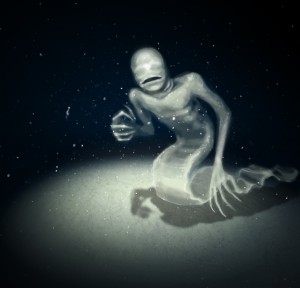An essay by Dr. Todd Forest, as provided by Christine Layton. Salvaged from Seaforming Expedition (Program Terminated).
Art by Leigh Legler
“Do you think they ever travel?” I watched the mattress of the bunk above dip and shift as Donald rolled over onto his side. His round and florid face appeared over the edge of the top bunk and he fixed me with a beady stare.
“Are you going to keep asking me questions I don’t know the answer to? Or are we going to get some sleep?”
I cringed and pushed my glasses up on the bridge of my nose. “Sorry.”
“Some of us have work tomorrow,” Donald continued.
“Well so do I,” I said.
“I mean real work,” Donald smirked and then he withdrew. I stared at the mattress above me, which continued to dip and bend as Donald adjusted himself. “You keep asking questions about those Sea Monkeys but I got enough on my own plate, got me? I could give a flying flip about the Monkeys.”
“They’re not Sea Monkeys,” I said quietly, more to myself than to my bunkmate. They weren’t Sea Monkeys at all. And they weren’t Mermen either–the more affectionate but still incorrect moniker people were using on the continents. They were Aqua Sapiens–a term of my own coinage. And once I completed my research, the world would know a lot more about the mysterious creatures.
I drew my knees up and adjusted the small lamp attached to the post of my bunk. In the dim light, I arranged and rearranged the first chapter of my manuscript. It contained the background on the Aqua Sapiens, their original discovery, which occurred only last year, but already felt like a lifetime ago.
The first exploration team to the ocean floor had been purely scientific. In a bulky iron orb capable of withstanding the immense pressure of the ocean’s atmosphere, they descended over the course of two months, sinking slowly to the floor of the ocean. A more rapid descent was not possible, as the structural integrity of the submarine would be jeopardized. But they made it to the ocean floor–the first people to do so in history.
For the first time in the history of the Earth, light shone across the sea floor–a weak beam from an impossibly thick-glassed search light affixed to the iron submarine. Back on the continents, people had crowded around their flat screen TVs to see. At first they held their breath in anticipation of something momentous, like the moon walk a century before. Then after half an hour of dark and blurry footage of an ocean floor that looked no different from the carpet in their living rooms, people began to lose interest. Many had turned the channel by the time of the occurrence. The time stamp reads 37 minutes, 45 seconds when a gray figure suddenly darts past the corner of the screen. The reaction of one of the scientists–“Jesus Christ!” is recorded loud and clear on the footage. Ten seconds later the figure reappears, darting at the corner of the screen at first, and then, finally, it drifts fully into the shot. The figure is humanoid from the waist up. The legs do not end in feet, though. Instead they melt into a rippling ribbon of thin flesh, which moves in constant waves. The rippling dermis both propels and stabilizes the figure, as it floats a few inches above the sea floor. When the figure turns toward the camera to snatch at a particle suspended in the weak light of the lantern, the large gray head is fully revealed. Eyeless, hairless, only a mouth, and when the form catches the particle with slender long fingers and quickly opens its mouth to receive the food, it has no teeth–only a long bony strip, like the mouth of a fish that munches on coral and grinds its food into mash.
To read the rest of this story, check out the Mad Scientist Journal: Spring 2014 collection.
Dr. Todd Forest, professor of linguistic theory, syntax, semantics, and the philosophy of language, was last seen on submersion day, 2013. A floating buoy marks the approximate location of the abandoned Seaforming site in the Pacific Ocean. On it, the names of the many engineers lost are recorded. At the bottom of the list, under his bunkmate Donald Manly, Dr. Forest’s name is preserved forever.
Christine Layton lives and writes in the Chihuahua Desert. Her nonfiction work can be found on Cracked.com. Her fiction work can be found at the bottom of the sea.
Leigh’s professional title is “illustrator,” but that’s just a nice word for “monster-maker,” in this case. More information about them can be found at http://leighlegler.carbonmade.com/.
Follow us online:
